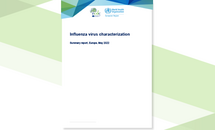Influenza virus characterisation - Summary Europe, March 2021
ECDC’s influenza virus characterisation reports are published periodically and give an overview of circulating influenza viruses. They provide details on the current vaccine strains, summarise the development of the viruses since the last report, and closely follow the main developments for the ongoing influenza season. Virus characterisation reports are primarily intended for influenza virologists and epidemiologists.
Executive Summary
This is the fifth report for the 2020-2021 influenza season. As of week 12/2021, only 758 influenza detections across the WHO European Region had been reported to The European Surveillance System (TESSy); 50% type A viruses, with A(H3N2) and A(H1N1)pdm09 being equally represented, and 50% type B viruses, with only 12 having been ascribed to a lineage, 10 B/Victoria and two B/Yamagata. This represents a 99.5% drop in detections compared with the same period in 2020, probably due to the COVID-19 pandemic and measures introduced to combat it.
Since the February 2021 characterisation report, no shipments from European Union/European Economic Area (EU/EEA) countries have been received at the London WHO Collaborating Centre, the Francis Crick Worldwide Influenza Centre (WIC): consequently, no new virus characterisation data have been generated. This report therefore focuses on genetic characterisation of the HA genes of seasonal influenza viruses based on sequences deposited and/or released in GISAID during March 2021, compared with the situation reported in the February 2021 characterisation report. The most recent data continues to show extremely low levels of influenza detections across North America and Europe. Globally, few or no detections of A(H1N1)pdm09 and B/Yamagata-lineage viruses have been reported while new variants of A(H3N2) and B/Victoria-lineage viruses have emerged, with the majority of detections reported by Asian and West African countries with evidence of wider geographic spread.
Download








